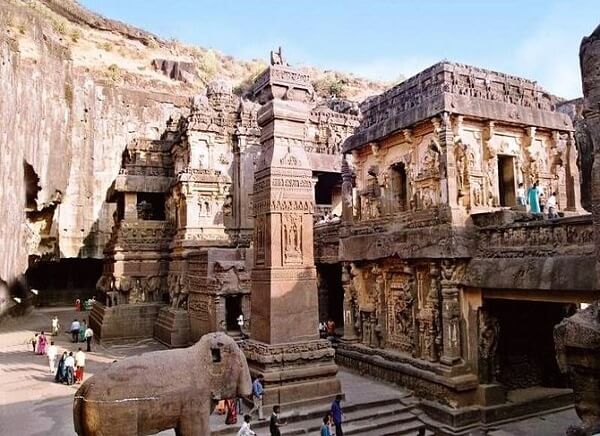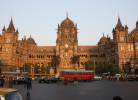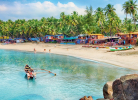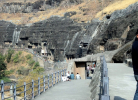Ellora Caves Aurangabad, Maharashtra
Visitor Information:

-
Famous For History, Photography, Sculptures, Carvings
-
Fee Guide in Detailed Below
-
Visiting Time 8:00AM - 5:30 PM
-
Duration of Visit 2 to 3 hours
Ellora group of caves is a famous heritage site of India. The Ellora Caves is the world’s largest rock-cut styled monastery cave. The caves are dedicated to different deities of different religions like Jainism, Buddhism, and Hinduism.
There are more than 100 caves located in this region and only 34 are open to tourist and these 34 are famous for its heritage, culture and religious importance.
The Ellora Caves is one of the most commonly visited sites of the country and it has an interesting place in luxury train itineraries too.
Location of Ellora Caves
The caves are located on Charanandri Hills, 29 km outside Aurangabad district, Maharashtra. The caves are located on the flat rocky surface of Western Ghats. The rocks were formed millions of years ago due to volcanic activity.
History of Ellora Caves
According to archeologists, most of the artwork, monuments, and structures belong between 600 AD and 1000 AD. Although the caves belong to different religions, they were all built during different Hindu dynasties like the Rashtrakuta Dynasty, Yadava Dynasty, and others.
The funding for these caves came from royal families, wealthy merchants, pilgrims, and others. The location of this site is on the ancient trade route of South Asia.
According to archeologists, the caves were built in three different phases, one for each religion. The early Hindu period lasted between 550 AD and 600 AD. The Buddhist phase lasted between 600 AD and 730 AD and the last period belonged to Jains between 730 ADand 950 AD.
The caves were active pilgrimage sites in the past and the activity ceased after the 13th century. In the 13th century, the region of Ellora Caves came under the control of Delhi Sultanate and was abandoned. Many sculptures and caves were damaged by Islamic invaders between the 15th and 17th centuries.
Later, during the reign of Aurangazeb, the caves were ordered to be demolished. However, the troops were not able to damage the caves significantly. Later, the caves were left to ruin without any activity.
During the British era, the caves were restored and managed by committees. In 1983, Ellora Caves were recognized as a world heritage site and a legacy to Indian art forms.
Inside Ellora Caves
These caves are formed from basalt cliffs. The caves 1 - 12 are Buddhist Caves, Caves 13 - 29 are Hindu Caves and cave 30-34 are Jain Caves. These caves are built close to one another showing the harmony between the religions in the country.
The Buddhist caves hold viharas or monasteries. The monasteries belong to Gautama Buddha or other saints of the religion. The stones are polished to make it look like wood.
Hindu caves are mostly dedicated to Lord Shiva. You can also find a couple of Lord Vishnu temples. Mahavir and Indra are the top deities of Jainism caves.
Cave 1
This cave is located at the southern end of this group. This cave holds a small Buddhist Vihara. This vihara holds cells for monks. It is assumed that this cave was a residence for the cave workers and later was used by pilgrims and monks.
Cave 2
This cave holds carved compartments, pillars, and a verandah. You can find many carvings on the sides of this cave but, only a few structures remain.
You can find carvings of Buddha, Sakra, Indra, and others. The main shrine of the temple holds a 14 feet tall statue. There is a small structure of Amithabha Buddha with a rosary and lotus in hand. There is a large figure of Maya, Buddha’s mother.
Almost all the sculptures have lotus in hand.
Cave 3
This cave is lower to the ground and is a monastery. The front wall of the cave is destroyed along with a major part of a verandah. There is a square hall in the cave, supported by massive columns with octagonal structure.
There are twelve small cells and you can find small sculptures of Buddha in this cave. There is a chapel in the left corner of the cave with a main statue of Buddha in preaching pose. You can also find a Hindu goddess, Kali in this cave.
Cave 4
Most part of this cave has fallen as ruins. You can find a few figures in the cave likePadmapani, Buddha, dwarfs, and others. You can also find bas relief carvings in this cave.
Cave 5
This is one of the unique caves of this group. This cave has many refectory benches and a Buddha statue at the back. Cave 5 is called Mahawara cave. This cave was used by Mahar tribes. This is the largest vihara for the state. The roof of the cave is supported with 24 massive pillars of square shape.
You can find dining areas, resident rooms and even a monastic school in this vihara. The school holds a primitive form of benches, reading desks and others. The columns in the cave are ornately carved. There is a large shrine in the back of the cave with a large Buddha carvings and arched doors.
You can find numerous other figures in the shrine,like Padmapani and others. There is another shrine to the right of the cave, which is not open for tourists as the entrance is damaged.
Cave 6
The main hall of this cave is completely damaged. Only a few pillars stand now. The antechamber and the shrine of this cave are filled with sculptures.
You can find many Buddhist sculptures and a Hindu Goddess, Saraswati, the deity for learning and knowledge. On the north of the cave, you will find a small passage with balconies and cells on either side.
Cave 7
This cave holds a plain structure resembling Vihara with just four columns and a few cells. This cave is assumed to be incomplete.
Cave 8
This cave has a small shrine and dwarapalas. You can find sculptures of Buddha and other eminent figures.
Cave 9
This cave is famous for carved façade, balcony, portico, octagonal pillars, and Chaitya windows.
Cave 10
Cave 10 is also called as Visvakarma Cave. This is a famous Buddhist prayer hall. This was built during 650 AD and is also called as Carpenter Cave as the rock is given a wood-look. This stupa has a distinct cathedral styled architecture. There is a large Buddha statue (15 feet) in the cave. There are a few cells on either side of the statue and the construction of the caves look similar to Ajanta Caves.
The main hall of this cave holds 28 octagonal columns, plain bracket capital, and a central nave. The statue in this hall is a large Buddha figure with a Bodhi Tree behind him.
You can find naga queens and dancers carved on the pillars. On the entrance of the cave, you can find motifs of dancing ladies and meditating saints. The upper level of this cave has porticos and verandahs with a small shrine.
The other levels of this cave hold different deities like Bhrkuti, Maitreya, Avalokitesvara, Manjusri, Mahamayuri, and others. These were carved in the Pala Dynasty style. You can find a strong influence of South Indian architecture in this cave.
Cave 11
This cave is called Do Taal. This cave holds two floors. You can find shrines for Padmapani, Buddha, Vajrapani, and others. You can find numerous verandahs and cells in this cave. There are numerous sculptures in this cave.
Cave 12
This cave is called Teen Taal because it holds three floors. You can find floral ornamentation in this cave. You can find numerous sculptures of varying shapes and sizes here denoting Buddha, Padmapani, Vajrapani, and others.
You can find artwork representing the seven different Buddhas. You can also find some Hindu Goddesses here like Saraswathi, Lakshmi, and others.
Cave 13
In geographical positioning, this is the first Hindu cave. This cave holds some indication of Buddhist art too. This cave is almost plain and is assumed to be rest area for monks and workers.
Cave 14
This cave is called Ravanaki Kai. This is an early cave holding a large shrine and a pillared hall. You can find various Shiva and Parvathi related sculptures here.
The most notables ones are Lord Parvathi killing a demon in buffalo form, Lord Parvathi and Shiva playing dice, Shiva in dancing pose and so on.
You can also find sculptures representing Lord Vishnu and Lakshmi along with avatars of Lord Vishnu.
Cave 15
This cave is called the Dashavatara temple. This is a Hindu cave but, it has many layouts resembling a Buddhist cave.
Thus, it is assumed that the cave was first prepared for a Buddhist temple but, turned into a Hindu structure at later stages.
There are no major deities in this cave expect Nrtya Mandapa and Lord Vishnu is the entrance of the cave. The upper level of this cave has carvings of ten avatars of Lord Vishnu. The reliefs hold Saivam related carvings.
Cave 16
This is the most famous of all caves in the region. This cave holds the world’s largest excavation of a single monolithic rock. The temple is called as Kailash Temple. The temple is built in a chariot shape and is dedicated to Hindu deity, Shiva.
This temple also holds sculptures of numerous deities, mythological characters and others belonging to both sectors of Hinduism; Shaktism (Saivam) and Vaishnavism. The relief panels of this cave portraits many stories of Hindu Epics.
This temple is inspired by the pilgrimage spot, Mount Kailasha. You can find structures similar to many Hindu religious sites like assembly hall, shrines around the principle deity, space for performing circumambulation, sanctum sanctorum, and others. The best part is that this entire colossal structure was carved from out of a massive single rock.
You can also find many mythological characters and deities like Ardhanarishvara, Harihara, Durga, Annapurna, Agni, Surya, Vayu, Usha, and others. You can also find carvings of 12 stories belonging to the childhood of Lord Krishna.
This multi-level cave covers an area twice of Athen’s Parthenon and the removed stone during this construction would weigh 200,000 tons. This construction started in 756 AD and was completed in 773 AD.
This cave is famous for long corridors, carvings along with panels and other sculptures. There is an unfinished cave to the right end of this region. This cave is dedicated to Lord Shiva and you can find many carvings explaining mythological stories related to the deity.
Cave 17
This is a large cave with a large Shiva temple. You can find massive pillars and numerous sculptures in this cave. This cave is built in Dravidian style with floral decorations and heavy columns.
The main deity of the cave is damaged but, it is clearly a Linga. You can find other Hindu deities in the cave, like Mahishasuri, Ganesh, Gandharvas, and others.
Cave 18
This is an unfinished cave with pillars and a few inscriptions on the wall. The inscriptions are in Devanagiri style and a small pedestal for Nandi is erected along with a small trough, which is assumed to be a fire pit. With these structures, it is assumed that this cave should be dedicated to Lord Shiva.
Cave 19
This cave is located lower to the ground and it is a primitive-looking one. You can find pillars with elephant carvings and a small shrine with linga in it. There are a few carvings on the walls of this cave.
Cave 20
This cave holds a small shrine. Most of the structural elements of this cave are deeply damaged. You can find sculptures of other deities in the cave along with square pillars.
Cave 21
This cave is also called Rameshwar Lena. This is one of the early caves of the region, belonging to Kalachuri reign. This cave has carvings describing the story of Parvati’s life, her wedding with Lord Shiva, dancing of Shiva, Kartikeyan (Lord Murugan or Skanda) and others. You can find a large art of Sapta Matrika (seven mother forms of Shakthi).
Apart from these, you can find other mythological characters and deities like Lord Durga, Yamuna, Ganga and others.The cave holds a large square mandapa with geometric pattern design.
The Shiva’s linga is located from equal distance from Ganga and Yamuna (equilateral triangle design). This is an indication of gender equality that prevailed in the society during ancient times.
Cave 22
This cave holds a Nandi mandapa, which is almost in ruins. You can find chapel-style court areas, pillars, and sculptures of Hindu deity in this cave. You can find a polished linga in the main shrine, which blue streaks on it, representing the form, Nilakanta.
Cave 23
This is a low lying cave with double verandah, doors, pedestal and a sculpture of Trimurthi in the back-end wall of the cave.
Cave 24
This is a collection of five small cells and is called Oilman’s Mill. No sculptures are found in this cave. Based on the ceased progress of drilling, it is assumed that the sculptors found a flaw in the formation of rocks and decided that it was unfit for carving.
Cave 25
The iconic element of this cave is the large ceiling carving of Surya. This cave is called Kunbharwada. It holds six columns with sculptures on pedestals.
Cave 27
This is called the Milkmaid cave. If you visit during monsoon season, you will find a small waterfall in this cave, called Sita-ki-nahani. You can find carvings of Shiva, Vishnu, Brahma, Varaha and other Hindu gods in this cave. The back end of the cave holds a verandah.
Cave 28
This is a Vaishnava cave with carvings of Lord Vishnu, Lakshmi, and others. You can find a square-shaped altar, vestibule and a few cells in this cave.
Cave 29
This is one of the earliest caves of this region. This Hindu cave was built during the Kalachuri dynasty. The iconic element of this cave is a rock-cut main deity (linga) and a significant space has been given around the linga for pilgrims to perform circumambulation. This cave is also called Dhumar Lena. This cave holds a natural waterfall.
If you wish to spot this waterfall, you need to be standing from the balcony in the south of this cave. During monsoon season, the waterfall will flow right on to the linga. The carvings of this cave are very large and with disproportionate limbs.
Cave 30
This is quite smaller than other caves and is built with one symmetric mandapa, pillared veranda, worship area, and others. You can find sculptures of 24 Jinas. This cave is called Chotta Kailasha.
The carvings of this temple are quite similar to the Kailash Temple cave. You can find large relief showing Indra. There are theories stating that this cave was originally created as a Hindu cave and then turned into a Jain temple. You can find both Jain structures and Hindu structures in this cave
Cave 31
Unfinished cave with a small shrine and four-pillared hall. You can find carvings of Parshvanatha, Gommateshvara, YakshaDharanendra and others. The main idol of this cave is the Vardhamana Mahavir sitting on a lion throne.
Cave 32
Lord Indra is a Hindu god. While excavation, the historians confused the sculptures of Buddhist structures with Indra and named it as Indra Sabha.
However, this cave is predominantly a Jain structure and holds many deities and paintings related to Jain mythology. Many rituals are assumed to be taken place in the upper level of this cave.
Cave 33
This cave is called as Jagannatha Sabha. This is the second-largest cave belonging to Jainism. This cave holds carvings of elephant heads on the pillars.
The entire structure in this cave is built from one single rock. The major deities of this cave are Mahavira and Parshvanatha, two Tirthankaras of Jainism.
Cave 34
This cave has carvings of Sri Nagavarma, Goddess Ambika, Yaksa-Yakshi and others. The iconic element of this structure is a large lotus carving on the ceiling.
Paintings of Ellora Caves
The rock surface is covered with lime plaster and painting has been made on it. You can find free-standing paintings and paintings made on sculptures in Ellora. The painters applied the first coat of mud plaster to fill the pores of the walls.
Then, a lime plaster is add on top of it. It is allowed to dry and then, the outlines are drawn first with the help of red ochre paint. Once the outline is dried, they color all elements, which are in red, black, deep red or brown. Other colors are added in later stages.
You can find paintings of deities, demons, mythological stories, everyday items, animals and even imaginative figures. You can clearly see many Gujarathi styles in the painting. Jain paintings are the most damaged ones in this group.
Facts about Ellora Caves
- There is a small Jain temple with rock-cut structures on top of the hill, 600 steps above Ellora Caves. It is open for tourists and pilgrims
- Many Muslim rulers and traders have recorded their stay in the cells of Ellora Caves.
- Emperor Aurangazeb and other Mughal rulers frequently visited this site, especially during the rainy season
- Locals call this group of caves as Verul Leni.
- Ellora is famous for holding the world’s largest single rock excavation.
- Only 34 out of 100 caves are open for tourists.
- Although generally considered as nemesis, the cave structures indicate as Shaktism and Vaishnavam of Hinduism were in harmony during the ancient times.
- Drills, hammer, and chisel were used by the artisans during 500 AD for construction of these caves
- Plaster was used to represent snow in carvings like mountains
- Aurangazeb tried to destroy this cave group for three years using 1000 people but, he couldn’t demolish it and only ended up disfiguring a few structures.
Visiting Timing of Ellora Caves
Caves are open from 8 am to 5:30 pm. Ellora Caves are open throughout the year, six days a week (Tuesdays are weekly off)
Entry Fee of Ellora Caves
You can purchase tickets at the ticket counter or you can book throughout online.
- For children below the age of 15 – Free
- Entry fee for Indian – INR 40 per head
- Entry fee for BIMSTEC and SAARC citizens – INR 40 per head
- Entry fee for other foreigners – INR 600 per head
Best Time To Visit Ellora Caves
The best time to visit the caves is between November and March. This is the winter period of Maharashtra. It would take a couple of hours to explore the caves and humidity inside the cave will be very high during summer (March to June).
Monsoon is a beautiful time to visit but, transportation and sightseeing can be difficult. Finding public transportation to reach the caves will be hard and expensive during monsoon.
Rainy season extended between July and September. If you are visiting in winter, the place will be calm and cool. You can also enjoy a holistic vacation by exploring other important tourist attractions of the state.
If you are visiting during March, take part in the annual Ellora Festival, which takes place in the third week of the month. You can find many dance and music performances during this festival.
Also Read : Best Time to Visit Mumbai
How To Reach Ellora Caves
Once you are inside Aurangabad City, you can find buses and cabs to the cave. A car trip from the heart of the city to the caves starts from INR 1000 (four-seated car).
You can find buses from different parts of Aurangabad to caves. Usually, tourists find buses from the central bus stand of Aurangabad to Ellora.
Closest bus stand - Ellora bus stand (600 m away)
Closest railway station – Aurangabad railway station (28 km away)
Closest airport – Aurangabad airport (35 km away).
If you are choosing trains, you can find many trains running from regions around Maharashtra and surrounding states to Ellora. Top trains to choose are Sachkand Express, Ajanta Express, and Tapovan Express.
You can also choose Deccan Odyssey luxury train to cover Aurangabad. If you are planning to choose Deccan Odyssey, here are the top itineraries covering Aurangabad.
If you are flying to Aurangabad, you can find direct flights from Hyderabad, Delhi, and Mumbai.
Reaching Ellora Caves from Other Cities
Ellora Caves are not just accessible from Mumbai but it can be reach from other major cities too
How to Reach Ellora Caves from Delhi
Distance between Ellora Caves and Delhi – 1,215 km.
If you are choosing flights, you can find direct flights from Delhi to Aurangabad. It would take one hour to reach Aurangabad. From Aurangabad airport, you can find cabs, buses and other road transportation to reach Ellora Caves. Some prefer to book cabs or buses from Delhi to Ellora directly.
However, the distance is longer and the travel might be inconvenient and costly too. For more convenient travel, choose trains from Delhi to Aurangabad. Choose Indian Odyssey of Deccan Odyssey luxury train if you are looking for a pampering vacation.
There are numerous government buses running from Delhi to Aurangabad central bus stand. From the bus stand, you can find direct buses to Ellora Caves.
How to Reach Ellora Caves from Mumbai
Distance between Mumbai and Ellora caves – 341.6 km
If you are flying, you can find direct flights from Mumbai to Aurangabad. From Aurangabad, you can find buses, cabs and luxury coaches to reach Ellora.
If you are choosing buses or cabs, you can find direct transportation from Mumbai. Most of the buses will halt at Aurangabad Central bus stand. You can find trains from Mumbai to Aurangabad. Most of the trains will halt at Jalgaon station.
From the station, you can find cabs and buses to the caves. If you are choosing Deccan Odyssey, choose itineraries that would cover the monument. Not all itineraries would include Aurangabad.
How to Reach Ellora Caves from Pune
Distance between Pune and Ellora caves – 259 km
The best option is to take a train from Pune and de-board at Aurangabad Jalgaon station. From the station, you can find road transportation to the caves. You can also choose to hire buses or cabs directly from Pune.
If you are flying, you will have to catch a connecting flight at Hyderabad or New Delhi. The time taken for connecting flights will be longer. Thus, trains are a better option.
How to Reach Ellora Caves from Chennai
Distance between Chennai and Ellora Caves – 1229 km
Train from Chennai central to Pahur station would take 19 hours. You can find overnight trains, which will relatively make it feel shorter. Pahur station is around 20 km away from Ellora Caves. If you are flying, you will need to catch connecting flights at Hyderabad or Mumbai. You can find buses from Chennai to Mumbai or Delhi. However, the duration of travel will be very long.
How to Reach Ajanta Caves from Bangalore
Distance between Ellora Caves and Bangalore – 961.5 km
You can find overnight trains to Shirdi, Ahmedabad or Jalagon from Bangalore. From these stations, you can find cabs or buses to reach Aurangabad or Ellora. If you are flying, you should de-board at Hyderabad or Mumbai for connecting flights.
Some tourists prefer to fly to Pune and from Pune find cabs or buses to Aurangabad or Ellora. The shortest route will be overnight train to Bijapur and a road journey for 500 km.
Also Read : How to Reach Mumbai























